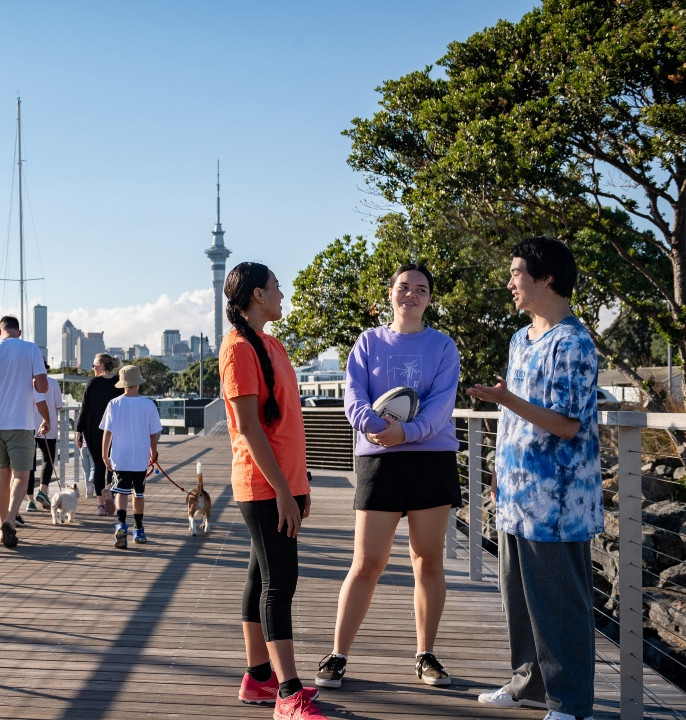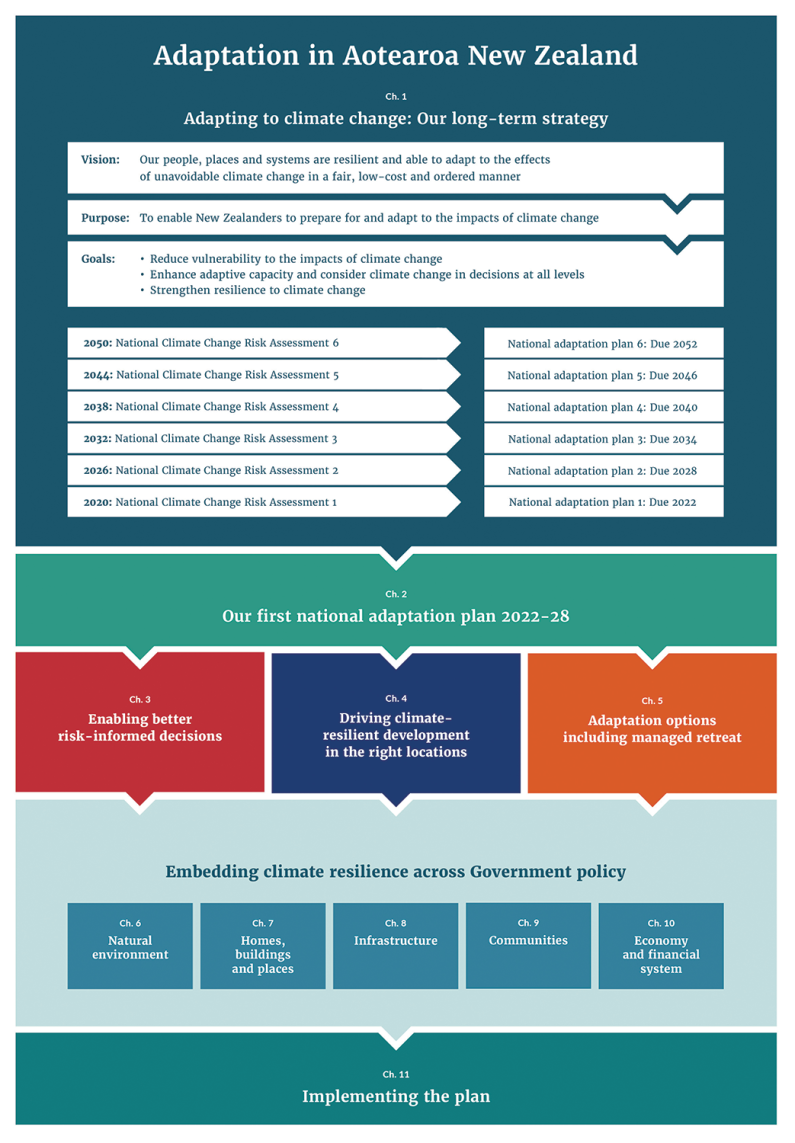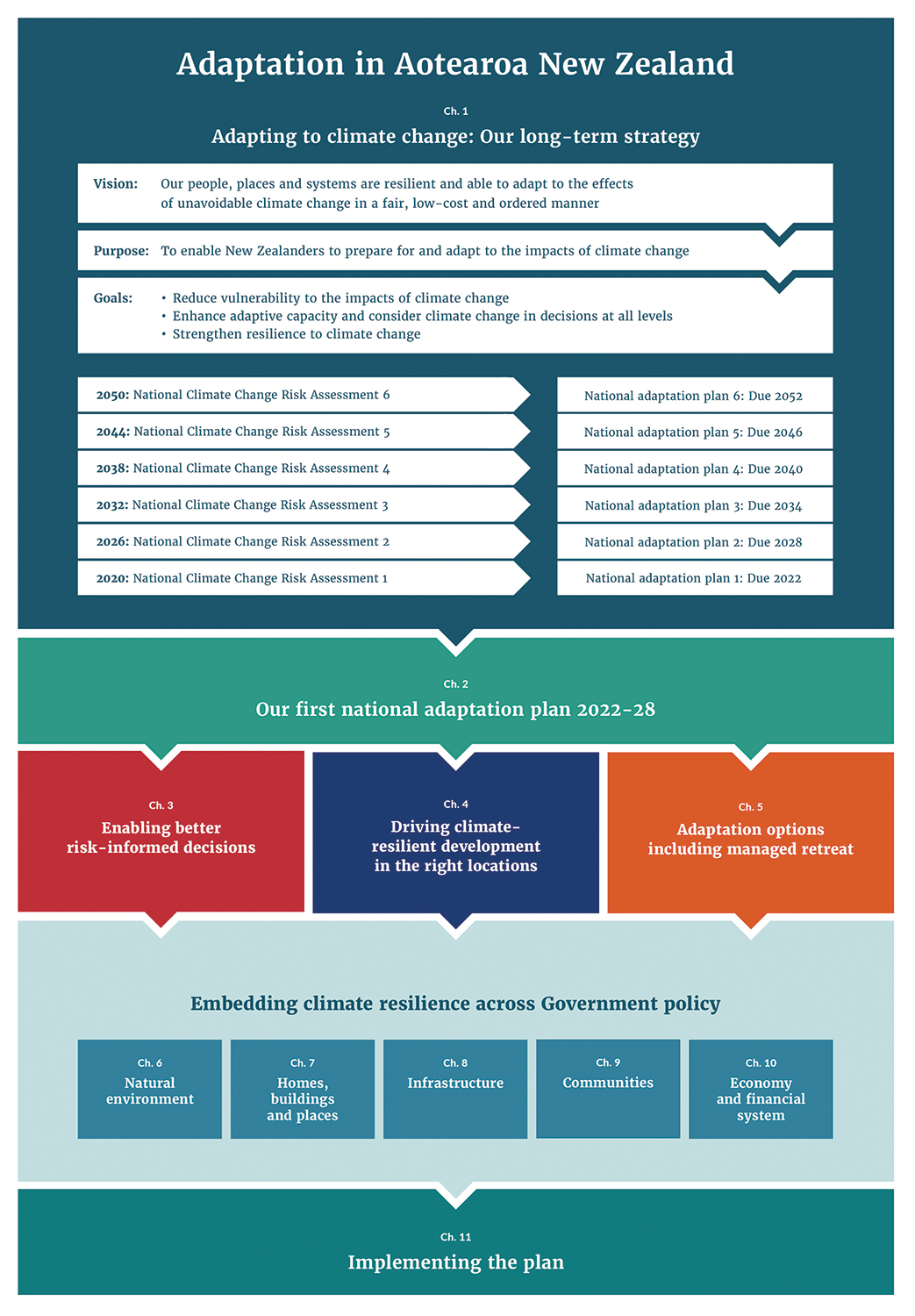Executive summary

This plan was published in 2022. Some actions in the plan were amended in January 2025 as part of the Government's response to the Climate Change Commission's national adaptation plan progress report. These updates reflect changes in circumstances since the plan was published and align with the Government’s climate strategy.
See the response and updated table of actions for more details.
Aotearoa New Zealand experiences a wide range of natural hazards – from earthquakes and volcanoes to erosion, landslides and extreme weather events.
Climate change will increase the severity and frequency of some of those hazards, including flooding, heatwaves, drought and wildfire. We will also face new risks as a result of slow-onset, gradual changes such as sea-level rise, ocean warming, more hot days, and more rainfall in some parts and less in others. If the number and value of assets increases, that can also contribute to increasing risk exposure over time. These effects will impact New Zealanders in different ways – and there is a risk that some groups may be disproportionately impacted.
How much change we will see, and how fast that change will happen, is not certain. We have greater certainty about change in the medium term, but need to plan for longer time horizons. As our climate continues to change, the impacts and risks that we face will also evolve.
Changing the way we do things to emit less greenhouse gases and limit global warming is an important step towards adapting to the effects of climate change. That’s why the first emissions reduction plan [PDF, 6.9 MB] sets us on track towards a low-emissions, resilient economy.
But the climate has warmed by 1.1°C in the last 100 years and we are already seeing the devastating effects. We know there are uncertainties that come with our changing climate – and we have heard from New Zealanders that there’s no time to waste. Taking action now will set the foundations for more climate-resilient communities and take account of climate risk in everything we do.
This document sets out Aotearoa New Zealand’s long-term strategy and first national adaptation plan. The long-term strategy sets out the Government’s approach to adaptation. This first national adaptation plan, and subsequent plans, will be prepared and implemented in accordance with this strategy.
The first national adaptation plan contains Government-led strategies, policies and proposals that will help New Zealanders adapt to the changing climate and its effects – so we can reduce the potential harm of climate change, as well as seize the opportunities that arise. It responds to the risks identified in the National Climate Change Risk Assessment 2020 [PDF, 5.1 MB], which was prepared under the Climate Change Response Act 2002. It also draws upon the latest science from the Intergovernmental Panel on Climate Change and builds on recommendations of the Climate Change Adaptation Technical Working Group from 2018.
Adapting to the effects of climate change is a continuous process. We need to assess climate risks, plan and implement adaptation actions, then determine whether those actions were effective in reducing risks. For that reason, this plan is the first in a series of national adaptation plans that will be prepared every six years. Each plan will respond to a new national climate change risk assessment. All New Zealanders will be able to have their say on each plan.
Several actions to address these risks are already underway. The Government is reforming the resource management system, emergency management system and three waters services, and reviewing the future for local government. All these programmes of work aim to keep our systems fit for the future and responsive to the uncertainty of a changing climate.
Other major actions signalled in this plan that will support Aotearoa to build resilience and adapt to a changing climate include: a platform to work with Māori on climate actions; risk and resilience and adaptation information portals which will provide access to information; a rolling programme of targeted guidance; and a programme of work to unlock investment in climate resilience.
Together, the emissions reduction plan and this national adaptation plan form Aotearoa New Zealand’s first comprehensive climate change mitigation and adaptation response.
This executive summary outlines:
Below is a map outlining Aotearoa New Zealand’s long-term strategy and first national adaptation plan. The map points you to the chapters of this document, where you can dive into as much or as little detail as you want.

Vision: Our people, places and systems are resilient and able to adapt to the effects of unavoidable climate change in a fair, low-cost and ordered manner.
Purpose: To enable New Zealanders to prepare for and adapt to the impacts of climate change.
Goals:
| 2050: National Climate Change Risk Assessment 6 | National adpatation plan 6: Due 2052 |
| 2044: National Climate Change Risk Assessment 5 | National adpatation plan 5: Due 2046 |
| 2038: National Climate Change Risk Assessment 4 | National adpatation plan 4: Due 2040 |
| 2032: National Climate Change Risk Assessment 3 | National adpatation plan 3: Due 2034 |
| 2026: National Climate Change Risk Assessment 2 | National adpatation plan 2: Due 2028 |
| 2020: National Climate Change Risk Assessment 1 | National adpatation plan 1: Due 2022 |

Vision: Our people, places and systems are resilient and able to adapt to the effects of unavoidable climate change in a fair, low-cost and ordered manner.
Purpose: To enable New Zealanders to prepare for and adapt to the impacts of climate change.
Goals:
| 2050: National Climate Change Risk Assessment 6 | National adpatation plan 6: Due 2052 |
| 2044: National Climate Change Risk Assessment 5 | National adpatation plan 5: Due 2046 |
| 2038: National Climate Change Risk Assessment 4 | National adpatation plan 4: Due 2040 |
| 2032: National Climate Change Risk Assessment 3 | National adpatation plan 3: Due 2034 |
| 2026: National Climate Change Risk Assessment 2 | National adpatation plan 2: Due 2028 |
| 2020: National Climate Change Risk Assessment 1 | National adpatation plan 1: Due 2022 |
Vision: Our people, places and systems are resilient and able to adapt to the effects of unavoidable climate change in a fair, low-cost and ordered manner.
Purpose: To enable New Zealanders to prepare for and adapt to the impacts of climate change.
Goals:
| 2050: National Climate Change Risk Assessment 6 | National adpatation plan 6: Due 2052 |
| 2044: National Climate Change Risk Assessment 5 | National adpatation plan 5: Due 2046 |
| 2038: National Climate Change Risk Assessment 4 | National adpatation plan 4: Due 2040 |
| 2032: National Climate Change Risk Assessment 3 | National adpatation plan 3: Due 2034 |
| 2026: National Climate Change Risk Assessment 2 | National adpatation plan 2: Due 2028 |
| 2020: National Climate Change Risk Assessment 1 | National adpatation plan 1: Due 2022 |
In the past 100 years, our climate has warmed by 1.1°C, and in 2021 Aotearoa experienced its warmest year on record.* Sea-level rise is accelerating and extreme weather events – such as storms, heatwaves and heavy rainfall – are projected to become more frequent and intense.**
This poses a complex challenge as we must adapt to both slow-onset changes, such as rising sea levels, and increased frequency and magnitude of extreme events. The Climate Change Response Act 2002 sets out the process for assessing and understanding the risks posed by climate change, and taking action to manage these.
Changing the way we do things – so our people, natural environment, built places and systems are resilient and can adapt – is an enormous challenge. But we can meet it by working together now to understand the risks, and taking action to manage them. Alongside central government, local government, the private sector, iwi, hapū, whānau, communities and individuals all have different but complementary roles to play to build a climate-resilient Aotearoa.
Upholding the principles of Te Tiriti o Waitangi is a central aspect of the Government’s long‑term adaptation strategy. This means developing adaptation responses in partnership with Māori, elevating te ao Māori and mātauranga Māori in the adaptation process and empowering Māori in adaptation planning for Māori, by Māori. Māori face particular infrastructure challenges in rural and remote areas, and are vulnerable to road closures, power cuts and impacts on marae and other sites of cultural significance.
No two communities will experience climate change in the same way. Inequity arises through multiple domains including income, housing, employment and accessibility. Climate change can also increase existing inequities. Some groups may be disproportionately affected by financial impacts or lack the resources to adapt. An equitable transition is core to our adaptation strategy and national adaptation plans must support New Zealanders in ways that recognise their unique needs, values and circumstances.
The following goals underpin Aotearoa New Zealand’s adaptation strategy:
* See the Aotearoa New Zealand Climate Summary: 2021 from NIWA [PDF, 1.8 MB]
** See the Climate Change Projections for New Zealand: Atmosphere Projections Based on Simulations from the IPCC Fifth Assessment, 2nd Edition [PDF, 8.1 MB]
This plan is the first step towards meeting the Government’s long-term vision and goals for a climate-resilient Aotearoa.
The National Climate Change Risk Assessment 2020 identified 43 priority risks (see Appendix 2) that Aotearoa faces from climate change and outlines the 10 most significant risks across five domains (natural, human, economy, built and governance).
The national adaptation plan must address the most significant risks. This plan will help address all 43 risks, and the risk to the telecommunications network.
Four priorities underpin the plan:
To address specific realms of risk, the plan includes actions that relate to:
The Government has identified a series of objectives that drive the actions. These relate to either system-wide issues or the outcome areas above. Many actions will help us achieve more than one objective.
Actions are identified as either critical, supporting or proposed. We must start on critical actions now. Supporting actions are either less urgent, or are dependent on the critical actions. Proposed actions are future work programmes that reflect current thinking about what will be needed in future.
Eight critical actions will provide information, scenarios and guidance to help decision makers. Some actions apply to all New Zealanders, while others are for specific sectors and groups.
|
Critical actions to enable better risk-informed decisions |
|||
|---|---|---|---|
|
Establish a platform for Māori climate action |
Provide access to the latest climate projections data |
Design and develop risk and resilience and climate adaptation information portals |
Deliver a rolling programme of targeted adaptation guidance |
|
Develop guidance for assessing risk and impact on physical assets and the services they provide |
Raise awareness of climate hazards and how to prepare |
Support high-quality implementation of climate-related disclosures and explore expansion |
Improve natural hazard information on Land Information Memoranda |
Read more in chapter 3: Enabling better risk-informed decisions.
Many of our communities are located in places that are likely to see the impacts of climate change increase.
Seven critical actions will ensure that our planning and infrastructure investment systems are updated now, so they guide climate-resilient development in the right locations.
|
Critical actions to drive climate-resilient development in the right locations |
|||
|---|---|---|---|
|
Reform the resource management system |
Reform institutional arrangements for water services |
Integrate adaptation into Waka Kotahi decision-making |
Integrate adaptation into Treasury decisions on infrastructure |
|
Embed adaptation in funding models for housing and urban development, including Māori housing |
Set national direction on natural hazard risk management and climate adaptation through the National Planning Framework |
Establish an initiative for resilient public housing |
|
Read more in chapter 4: Driving climate-resilient development in the right locations.
Many communities are already experiencing natural hazard events such as flooding, and these are expected to increase over time.
Nine critical actions will support councils, communities, businesses and individuals to consider adaptation options available for their area, including managed retreat where necessary. Some actions apply to all New Zealanders while others are for specific sectors and groups.
|
Critical actions to facilitate adaptation options including managed retreat |
||
|---|---|---|
|
Pass legislation to support managed retreat |
Complete case study to explore co‑investment for flood resilience |
Publish the programme of work on how Aotearoa meets the costs of climate change and invests in resilience |
|
The Future for Local Government review |
Scope a resilience standard or code for infrastructure |
Reduce and manage the impacts of climate hazards on homes and buildings |
|
Prioritise nature-based solutions |
Support kaitiaki communities to adapt and conserve taonga/cultural assets |
Develop options for home flood insurance |
Read more in chapter 5: Adaptation options including managed retreat.
A priority of this plan is to embed climate resilience in all government strategies and policies.
Chapters 6–10 set out critical actions, supporting actions and future work programmes for each of the outcome areas. Below is a snapshot of critical actions that will help achieve the objectives for each of the outcome areas.
|
Actions critical to chapter 6: Natural environment |
|||
|---|---|---|---|
|
Implement the Department of Conservation Climate Adaptation Action Plan |
Implement Te Mana o te Taiao – Aotearoa New Zealand Biodiversity Strategy |
Implement key freshwater management programmes |
Engage with councils to implement the New Zealand Coastal Policy Statement |
|
Deliver climate, biodiversity, and wider environmental outcomes |
Deliver biosecurity actions to protect our indigenous ecosystems and economy from invasive species |
Implement the National Policy Statement on Freshwater Management 2020 |
Implement the proposed National Policy Statement on Indigenous Biodiversity |
|
Actions critical to chapter 7: Homes, buildings and places |
||
|---|---|---|
|
Reduce and manage the impacts of climate hazards on homes and buildings |
Reduce the exposure of public housing tenants to climate hazards |
Embed adaptation in funding models for housing and urban development, including Māori housing |
|
Support kaitiaki communities to adapt and conserve taonga/cultural assets |
|
|
|
Actions critical to chapter 8: Infrastructure |
||
|---|---|---|
|
Develop guidance to support asset owners to understand and manage the risks of climate change on physical assets |
Scope a resilience standard or code for infrastructure |
Integrate adaptation into Treasury decisions on infrastructure |
|
Develop and implement the Waka Kotahi Climate Adaptation Plan |
|
|
|
Actions critical to chapter 9: Communities |
||
|---|---|---|
|
Modernise the emergency management system |
Develop the Health National Adaptation Plan |
Raise awareness of climate hazards and how to prepare |
|
Actions critical to chapter 10: Economy and financial system |
||
|---|---|---|
|
Deliver the New Zealand Freight and Supply Chain Strategy |
Help financial entities to better identify and manage their climate risks and support financial stability |
Strengthen the fisheries management system and support the aquaculture sector to sustainably grow |
|
Develop options for home flood insurance |
Support high-quality implementation of climate-related disclosures and explore expansion |
|
This plan involves many agencies, departments and ministries. Making it work requires new ways of coordinating effort across government, as well as with our Tiriti partners and with local government, the business community and civil society.
Successful implementation will involve:
A climate change interdepartmental executive board will oversee the emissions reduction plan and national adaptation plan, and report on progress. The Climate Change Response Ministers Group, chaired by the Prime Minister, will oversee the plan and drive progress.
Every two years, He Pou a Rangi – Climate Change Commission will report to the Minister of Climate Change on the implementation and effectiveness of the national adaptation plan.

Executive summary
August 2022
© Ministry for the Environment